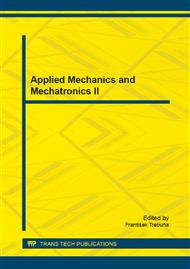[1]
M. Zmindak, P. Novak, V. Dekys, Z. Pelagic, Finite element thermo-mechanical transient analysis of concrete structure, Procedia Engineering 65 (2013) 224–229.
DOI: 10.1016/j.proeng.2013.09.034
Google Scholar
[2]
M. Chalecki, G. Jemielita, Free vibrations of non-homogeneous plate band, Engineering and Environmental Sciences 24 (2014) 317-331.
Google Scholar
[3]
Z. Bonic, T. Vacev, V. Prolovic, M. Mijalkovic, P. Dancevic, Mathematical modeling of materially nonlinear problems in structural analyses (part II – Application in contemporary software), Facta Universitatis – Series: Architecture and Civil Engineering 8 (2010).
DOI: 10.2298/fuace1002201b
Google Scholar
[4]
D. C. Drucker, W. Prager, Soil mechanics and plastic analysis or limit design, Quarterly of Applied Mathematics 10 (1952) 157–165.
DOI: 10.1090/qam/48291
Google Scholar
[5]
G. G. Boldyrev, A. Yu. Muyzemnek, I. M. Malyshev, Simulation of deformation processes in soils using the ANSYS and LS-DYNA software, in: Proceeding of the 6th Conference of Users of the Software CAD-FEM GMBH, Moscow, 2006, pp.9-20 (in Russian).
Google Scholar
[6]
G. Lacey, G. Thenoux, F. Rodriguez-Roa, Three-dimensional finite element model for flexible pavement analyses based on field modulus measurements, The Arabian Journal for Science and Engineering 33 (2008) 65-76.
Google Scholar
[7]
L. Sevelova, A. Florian, Comparison of material constitutive models used in FEA of low volume roads, International Journal of Civil, Structural, Construction and Architectural Engineering 7 (2013) 413-417.
Google Scholar
[8]
P. Sahoo, B. Chatterjee, D. Adhikary, Finite element based elastic-plastic contact behaviour of a sphere against a rigid flat – effect of strain hardening, International Journal of Engineering and Technology 2 (2010) 1-6.
DOI: 10.4236/eng.2010.24030
Google Scholar
[9]
V. Boucly, D. Nelias, I. Green, Modeling of the rolling and sliding contact between two asperities, Journal of Tribology 129 (2007) 235-245.
DOI: 10.1115/1.2464137
Google Scholar
[10]
C. J. Adam, M. V. Swain, The effect of friction on indenter force and pile-up in numerical simulations of bone nanoindentation, Journal of the Mechanical Behavior of Biomedical Materials, 4 (2011) 1554–1558.
DOI: 10.1016/j.jmbbm.2011.03.026
Google Scholar
[11]
N. Nikolov, T. Avdjieva, I. Altaparmakov, Length-scale effects and material models at numerical simulations of nanoindentation of a metallic alloy, Journal of Theoretical and Applied Mechanics 44 (2014) 25–40.
DOI: 10.2478/jtam-2014-0008
Google Scholar
[12]
M. Saadati, P. Forquin, K. Weddfelt, P. L. Larsson, F. Hild, Granite rock fragmentation at percussive drilling – experimental and numerical investigation, International Journal for Numerical and Analytical Methods in Geomechanics 38 (2014).
DOI: 10.1002/nag.2235
Google Scholar
[13]
T. J. Saksala, J. M. Makinen, Numerical modelling of bit-rock interaction in percussive drilling by manifold approach, in: A. Eriksson, G. Tibert (Eds. ) 23rd Nordic Seminar on Computational Mechanics Proceeding, KTH, Stockholm, 2010, pp.1-4.
Google Scholar
[14]
T. Saksala, 3D numerical modelling of bit-rock fracture mechanisms in percussive drilling with a multiple- button bit, International Journal for Numerical and Analytical Methods in Geomechanics 37 (2013) 325-330.
DOI: 10.1002/nag.2173
Google Scholar
[15]
H. M. Kuziomkina, А. О. Shimanovsky, V. I. Yakubovich, The special features of the deformation for the bearing building constructions with composite reinforcement, Procedia Engineering 48 (2012) 346–351.
DOI: 10.1016/j.proeng.2012.09.524
Google Scholar


